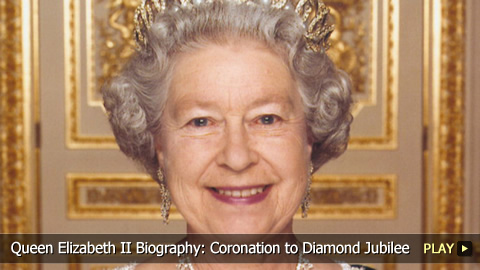Queen Elizabeth II Biography: Coronation to Diamond Jubilee

- Early Life
- Heiress Presumptive
- World War II
- Increasing Responsibilities
- Aiding the War Effort
- Marriage
- Children
- Ascension and Coronation
- Role of a Queen
- Decolonization
- Appoints A Successor
- Prince Charles Weds Lady Diana
- Falklands War
- The "Horrible Year"
- More Problems
- Golden Jubilee
- Renewed Popularity
- Personality
- Legacy
Early Life
Elizabeth Alexandra Mary was born April 21st, 1926 in Mayfair, London into the House of Windsor. She was the first child of the Duke and Duchess of York, otherwise known as Prince Albert and Elizabeth Bowes-Lyon.
Heiress Presumptive
In her youth, Elizabeth was not expected to become Queen, as her father was King George V’s second son. The King died in 1936, and her uncle ascended to the throne; however he famously abdicated for love. Elizabeth’s father then became King George VI, and she became heiress presumptive.
World War II
When World War II erupted in Europe, Elizabeth and her younger sister Margaret moved to Windsor Castle. From there, the 14-year-old future queen made a reassuring radio address directed at children who were affected by the war.
Increasing Responsibilities
Elizabeth’s public profile increased when she was named Colonel-in-Chief of the British Army’s Grenadier Guards. Her first unaccompanied public appearance was a visit the regiment in 1943. She also toured the country with her parents, and became Counsellor of State when the King was unavailable just before she turned 18.
Aiding the War Effort
In 1945, she trained with the Women’s Auxiliary Territorial Service as a driver and mechanic in an attempt to aid the war effort.
Marriage
Two years later, Elizabeth married Prince Philip of Greece and Denmark on November 20th at Westminster Abbey. The couple was labeled an odd one, due to Elizabeth’s subdued personality and Philip’s outspokenness.
Children
Just one year later, Elizabeth gave birth to their first of four children, Prince Charles. Princess Anne was born in 1950.
Ascension and Coronation
After a period of declining health, Elizabeth’s father King George VI died February 6th, 1952 while the Princess was visiting Kenya. She immediately became Queen, and returned home. Her official coronation took place on June 2nd, 1953.
Role of a Queen
As Queen, Elizabeth’s duties significantly increased: among her many responsibilities were weekly meetings with the Prime Minister, in addition to extensive travels throughout the United Kingdom and to other countries.
Decolonization
Queen Elizabeth gave birth to two more children in the 1960s. Meanwhile, decolonization efforts developed in some British colonies.
Appoints A Successor
In 1969, Queen Elizabeth officially appointed Prince Charles as her successor by investing him as the Prince of Wales. Later, she celebrated 25 years as Queen in 1977 with her Silver Jubilee.
Prince Charles Weds Lady Diana
While there was opposition to the Royal Family, in general its popularity soared. This was reinforced in 1981 when Prince Charles married Lady Diana Spencer.
Falklands War
Unfortunately, the country soon faced conflict. 1982’s Falklands War even involved the Royals directly as Prince Andrew fought for Britain.
1992: The “Horrible Year”
Things worsened in the ‘90s; in fact, 1992 is referred to as Queen Elizabeth’s “horrible year.” In addition to heavy hostility from the public and press, three of her children’s marriages crumbled, fire damaged Windsor Castle, and more.
More Problems
The downward spiral continued in 1996 when Charles and Diana, as well as Andrew and Sarah Ferguson finally divorced amid rumors of infidelity in both marriages. The next year, sentiment toward the Queen turned negative after Princess Diana was killed in a car crash. However, after her funeral, public resentment dispersed.
Golden Jubilee
In 2002, as she celebrated her Golden Jubilee, she also mourned the loss of both her sister and her mother. During that decade, the Queen also began showing signs of aging, and adapted her position on various topics. For example, she finally approved of Prince Charles’ relationship with Camilla Parker Bowles, and she became the first British monarch to visit Ireland since its independence.
Renewed Popularity
The monarchy was revived in 2011 by the wedding of Prince William to Catherine Middleton, and the Queen was instrumental in helping her grandson plan the day. However, the renewed popularity did nothing to dissuade criticism of the Royal Family’s finances. The next year, the Queen observed her diamond Jubilee, marking 60 years on the throne.
Personality
Despite living a public life, the Queen’s personality remained guarded. However, she is known to love equestrianism and tending to her Welsh Corgis.
Legacy
Queen Elizabeth II was born into royalty and rose to the task valiantly. Her poise, grace and wisdom were her greatest assets, and were cornerstones of her rule.


 0
0
 0
0
 report
report